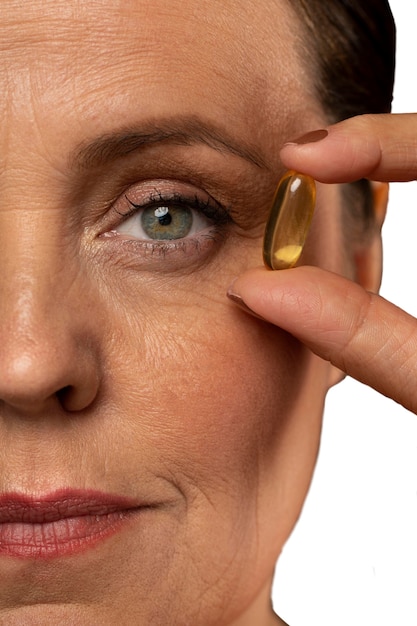Vitamin D is an essential nutrient that plays a critical role in maintaining the health of your bones, immune system, and skin. Deficiency in vitamin D can lead to various health problems, including significant skin-related issues. In this article, we’ll explore the effects of vitamin D deficiency on skin, the right dosage, and how to avoid deficiency by maintaining appropriate levels of vitamin D.
How Does Vitamin D Affect the Skin?
Vitamin D is crucial for skin health. It supports cell growth, repair, and metabolism and has anti-inflammatory properties. A deficiency can affect the skin in various ways, leading to problems like vitamin D deficiency skin spots or dry and irritated skin. Vitamin D also helps maintain the skin’s protective barrier, reducing the risk of infections and inflammation.
Common Skin Issues from Vitamin D Deficiency
- Dryness and Itching: One of the most visible effects of vitamin D deficiency on skin is dryness. Low vitamin D levels can contribute to chronic dry and itchy skin, which worsens in cold seasons or low-sunlight areas.
- Psoriasis: A lack of vitamin D has been linked to skin conditions like psoriasis. Patients with psoriasis often benefit from vitamin D supplements, which help reduce symptoms.
- Eczema: Insufficient vitamin D can aggravate or cause eczema, an inflammatory skin condition. The anti-inflammatory effects of vitamin D are crucial for managing this condition.
- Vitamin D Deficiency Skin Spots: One of the lesser-known effects is the appearance of spots or patches on the skin, which can range from pale to dark, depending on your skin tone.
Maximum daily dose of vitamin D
The maximum daily dose of vitamin D varies depending on age and health conditions, but for most adults, a dose of 600 to 800 IU per day is recommended. Some people may need to take more, especially if they suffer from severe deficiency. The right dosage can prevent the effects of vitamin D deficiency on skin and other health issues.
How Much Vitamin D shoul I take daily?
For most adults, the recommended dose of vitamin D3 is between 600 and 800 IU, but many wonder, “How much vitamin D3 per day for a woman?” or “How much vitamin D3 per day for a man?” The answer usually depends on individual health conditions. Regular intake can help mitigate the effects of vitamin D deficiency on skin and overall health.
Severe vitamin D deficiency symptoms
The effects of vitamin D deficiency on skin are often the first sign of a problem. deficiency causes skin-related issues like spots and dryness; severe deficiency can lead to more alarming symptoms. Severe vitamin D deficiency symptoms include bone pain, muscle weakness, and increased risk of cardiovascular diseases. In extreme cases, the deficiency can contribute to vitamin D deficiency causes which disease, such as rickets in children or osteomalacia in adults, both of which can affect your posture and bone health.
Vitamin D foods to Incorporate in Your Diet
A balanced diet can help combat the effects of vitamin D deficiency on skin. You can obtain vitamin D from natural sources, including sunlight exposure and certain foods. Vitamin D foods include fatty fish (salmon, mackerel, sardines), fortified milk, cheese, egg yolks, and mushrooms. Including these in your diet can help maintain optimal vitamin D levels and prevent deficiency-related skin issues.
Vitamin D3 Dosage for Adults Per Day
For adults looking to prevent deficiency, a common question is, how much vitamin D3 per day for adults? The usual recommendation is 600-800 IU, but some people may require a higher dose. If you’re wondering, can I take 5000 IU of vitamin D3 every day, the answer is yes, for those with a severe deficiency. However, it’s best to consult a healthcare provider before taking such high doses to avoid side effects.

Symptoms of Too Much Vitamin D
While vitamin D deficiency is common, excessive intake can lead to toxicity. The symptoms of too much vitamin D include nausea, vomiting, weakness, and frequent urination. In severe cases, too much vitamin D can lead to calcium buildup, causing kidney stones and heart problems. To avoid these symptoms, follow the recommended Vitamin D3 dosage for adults per day and avoid unnecessary over-supplementation.
14 Signs of Vitamin D Deficiency
It’s essential to recognize the signs of vitamin D deficiency early. Some of the 14 signs of vitamin D deficiency include:
Fatigue
Bone pain
Muscle weakness
Mood changes (depression or anxiety)
Hair loss
Slow wound healing- Vitamin D deficiency skin spots
Eczema
Psoriasis flare-ups
Dry skin
Increased susceptibility to infections
Joint pain
Sleep issues
Weight gain

Treating and Preventing vitamin D deficiency
To prevent or treat vitamin D deficiency, many people turn to Vitamin D tablets or supplements. The recommended dose varies, but daily intake between 600 IU to 2000 IU is safe for most individuals. For women, how much vitamin D3 per day for a woman can be adjusted based on deficiency levels and other health factors.
In conclusion, maintaining adequate vitamin D levels is crucial for overall health and skin condition. Both deficiency and excessive intake can cause serious problems, so it’s vital to monitor your vitamin D levels through a balanced diet and, if necessary, with vitamin D supplement usage.
Regular testing and consultation with a healthcare provider can help determine if you need to increase your intake or adjust it to avoid side effects. Whether through food or supplements, ensuring you have enough vitamin D can significantly improve your skin health and prevent related conditions like weird symptoms of vitamin D deficiency or the appearance of skin spots.
conclusion
In summary, vitamin D deficiency can have a profound impact on your skin, leading to issues such as dryness, itching, and the appearance of vitamin D deficiency skin spots. It can also exacerbate skin conditions like eczema and psoriasis. Adequate vitamin D levels are essential for maintaining healthy skin, and they also support overall well-being by strengthening bones, boosting the immune system, and reducing inflammation.
To prevent deficiency, it’s important to consume enough vitamin D foods, such as fatty fish, fortified dairy products, and egg yolks, or to consider a vitamin D supplement if necessary. The correct Vitamin D3 dosage for adults per day typically ranges from 600 to 800 IU, but individuals with more severe deficiencies may need higher doses. Always consult a healthcare professional to determine the right dosage for you, as excessive intake can lead to toxicity, with symptoms of too much vitamin D including nausea, vomiting, and potential kidney damage.
By monitoring your vitamin D levels and recognizing the 14 signs of vitamin D deficiency, you can take the necessary steps to maintain healthy skin and overall wellness.

Vitamin D Deficiency




